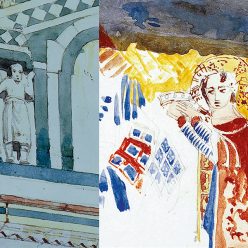Our third blog is by Francis O’Gorman, Saintsbury Professor of English Literature, University of Edinburgh; Honorary Visiting Professor, Ruskin Library and Research Centre, Lancaster University and Chairman of the Ruskin Society.
I’m a habitual visitor of graves. Most particularly, of the graves of writers and musicians. Because as a critic I am always writing about the actuality of an author—not as a mere ‘function’ of a text but as a once living and complex human being—graves have a particular significance. The material reality of an author is affirmed in some genuine, touchable way: there he or she is, on this spot, beneath this stone, beneath this grass. It have found it peculiarly moving to visit, for instance, Trollope’s grave and Wilkie Collins’s at Kensal Green;
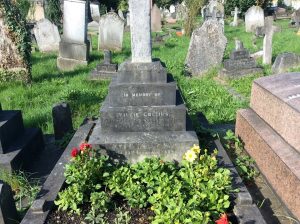 Wilkie Collins’s grave at Kensal Green Cemetery, the Royal Borough of Kensington and Chelsea, August 2015, author’s photograph.
Wilkie Collins’s grave at Kensal Green Cemetery, the Royal Borough of Kensington and Chelsea, August 2015, author’s photograph.
the Brontës at Haworth and Scarborough; Clough and Elizabeth Barrett Browning in Florence. Borrowing a term from Catholic Christianity, George Steiner thinks of the ‘real presence’ of creative artists behind their work. For me, what enhances that felt experience in reading is knowing where, and having visited, the final resting place.
But it isn’t only graves. It is also, far more cheerfully, birthplaces. Of course, there is only memory here, not mortal remains. But starting places, the location of first memories, have a role in helping one grasp the shape of an author’s life. I have just, for instance, been to Higher Bockhampton to see—for the first time since the summer of 1976—the Hardys’ beautifully cared-for cottage where their baby, Thomas, was born on 2 June 1840.
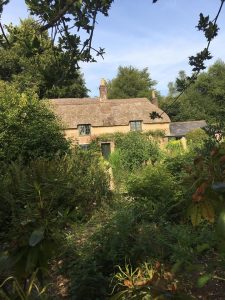
Hardy’s birthplace, Higher Bockhampton, Dorset, July 2018, author’s photograph.
Ruskin, as everyone knows, is buried in St Andrew’s Churchyard, Coniston, under W.G. Collingwood’s unRuskinian Celtic cross made from local slate. He is still among the hills, which he had loved since infancy. But Ruskin’s birthplace has suffered far more than Hardy’s. Anthony Trollope’s birthplace was demolished by the University of London in the 1930s and its location is now under the car-park of Senate House, off Russell Square.
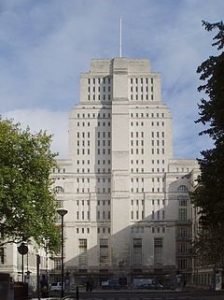
Charles Holden’s Senate House for the University of London (1932-7), on top of the site of Trollope’s birthplace. Image available through Creative Commons, https://en.wikipedia.org/wiki/Senate_House,_London#/media/File:Senate_House,_University_of_London.jpg
Just a few hundred metres away, Ruskin’s birthplace has also vanished.
As we all know, Ruskin was born on 8 February 1819 in 54 Hunter Street, Brunswick Square. And as we all also know, the house no longer stands. It was one of those demolished to make way for the construction of Patrick Hodgkinson’s Brunswick Centre, a Modernist shopping and residential complex. The Brunswick is still there, both admired and disliked.
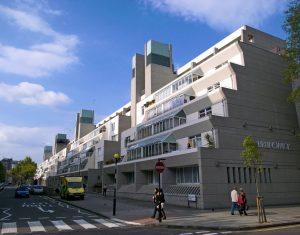
The Brunswick Centre, on the site of Ruskin’s birth which was almost exactly half-way between the front of the ambulance and the ‘lollipop’ crossing signal. Image available through Creative Commons, https://en.wikipedia.org/wiki/Brunswick_Centre#/media/File:Brunswick_Centre_(4136275375).jpg
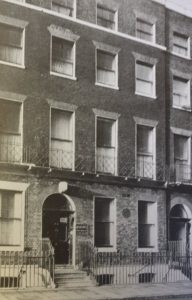 54 Hunter Street (note the plaque marking Ruskin’s birthplace). Online uncopyrighted image.
54 Hunter Street (note the plaque marking Ruskin’s birthplace). Online uncopyrighted image.
But there has been a long-standing effort, led by Dr James S. Dearden MBE, and now taken up by me, to mark the spot of Ruskin’s birth with a blue plaque or some other form of lasting commemoration. Jim has been able to retain a memory of exactly where the spot is, which is a blessing. He visited the house, then in an almost derelict state, on 1 January 1969, in the company, as it happens, of Spike Milligan, shortly before 54 Hunter Street was pulled down.
Jim photographed some of the property and has written several times giving more details of his visit. When the house was, shortly afterwards, demolished, what was immediately put in its place was the entrance to an underground carpark that served the residents of the Brunswick Centre. But that has now gone too. All that stands of any visible Ruskinian interest are the two remaining unaltered houses of Hunter Street (nos. 3 and 4) that were once directly opposite number 54. In the opening chapter of Praeterita (1885-9), Ruskin remarks that as a child he counted the bricks of the ‘opposite houses’ (Library Edition, xxxv.21).You can still do that in person or via Google Street View. https://mapstreetview.com/#uod2l_-2n26_1h.5_5f43 will take you straight there.
Let’s hope we can mark the location of this lost house permanently. There are other ‘sites’, after all, which have blue plaques near-by, not least that of Dickens’s Tavistock House, more or less round the corner, where the novelist lived from 1851 to 1860. The site of John Ruskin’s birthplace has every reason to be remembered. I hope I can complete what Jim has started.
Francis O’Gorman
Saintsbury Professor of English Literature, University of Edinburgh
Honorary Visiting Professor, Ruskin Library and Research Centre, Lancaster University
Chairman of the Ruskin Society
